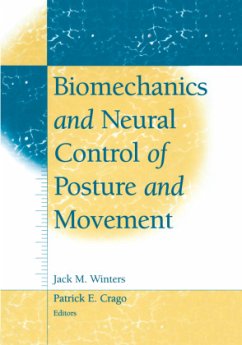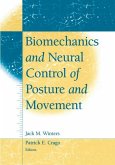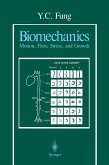Jack Winters / Patrick E. Crago (eds.)
Biomechanics and Neural Control of Posture and Movement
Herausgegeben:Winters, Jack M.; Crago, Patrick E.
Jack Winters / Patrick E. Crago (eds.)
Biomechanics and Neural Control of Posture and Movement
Herausgegeben:Winters, Jack M.; Crago, Patrick E.
- Gebundenes Buch
- Merkliste
- Auf die Merkliste
- Bewerten Bewerten
- Teilen
- Produkt teilen
- Produkterinnerung
- Produkterinnerung
Most routine motor tasks are complex, involving load transmission through out the body, intricate balance, and eye-head-shoulder-hand-torso-leg coor dination. The quest toward understanding how we perform such tasks with skill and grace, often in the presence of unpredictable perturbations, has a long history. This book arose from the Ninth Engineering Foundation Con ference on Biomechanics and Neural Control of Movement, held in Deer Creek, Ohio, in June 1996. This unique conference, which has met every 2 to 4 years since the late 1960s, is well known for its informal format that promotes…mehr
Andere Kunden interessierten sich auch für
![Biomechanics and Neural Control of Posture and Movement Biomechanics and Neural Control of Posture and Movement]() Biomechanics and Neural Control of Posture and Movement221,99 €
Biomechanics and Neural Control of Posture and Movement221,99 €![Biomechanics Biomechanics]() Y.C. FungBiomechanics217,99 €
Y.C. FungBiomechanics217,99 €![Biomechanics Biomechanics]() Y.C. FungBiomechanics216,99 €
Y.C. FungBiomechanics216,99 €![Biology and Mechanics of Blood Flows Biology and Mechanics of Blood Flows]() Marc ThirietBiology and Mechanics of Blood Flows117,99 €
Marc ThirietBiology and Mechanics of Blood Flows117,99 €![Biology and Mechanics of Blood Flows Biology and Mechanics of Blood Flows]() Marc ThirietBiology and Mechanics of Blood Flows77,99 €
Marc ThirietBiology and Mechanics of Blood Flows77,99 €![Sensory Processing in Aquatic Environments Sensory Processing in Aquatic Environments]() Shaun P. Collin / N.Justin Marshall (eds.)Sensory Processing in Aquatic Environments233,99 €
Shaun P. Collin / N.Justin Marshall (eds.)Sensory Processing in Aquatic Environments233,99 €![Cell Volume and Signaling Cell Volume and Signaling]() Peter LaufCell Volume and Signaling113,50 €
Peter LaufCell Volume and Signaling113,50 €-
-
-
Most routine motor tasks are complex, involving load transmission through out the body, intricate balance, and eye-head-shoulder-hand-torso-leg coor dination. The quest toward understanding how we perform such tasks with skill and grace, often in the presence of unpredictable perturbations, has a long history. This book arose from the Ninth Engineering Foundation Con ference on Biomechanics and Neural Control of Movement, held in Deer Creek, Ohio, in June 1996. This unique conference, which has met every 2 to 4 years since the late 1960s, is well known for its informal format that promotes high-level, up-to-date discussions on the key issues in the field. The intent is to capture the high quality ofthe knowledge and discourse that is an integral part of this conference series. The book is organized into ten sections. Section I provides a brief intro duction to the terminology and conceptual foundations of the field of move ment science; it is intended primarily for students. All but two of the re maining nine sections share a common format: (l) a designated section editor; (2) an introductory didactic chapter, solicited from recognized lead ers; and (3) three to six state-of-the-art perspective chapters. Some per spective chapters are followed by commentaries by selected experts that provide balance and insight. Section VI is the largest section, and it con sists of nine perspective chapters without commentaries.
Produktdetails
- Produktdetails
- Verlag: Springer / Springer New York / Springer, Berlin
- Artikelnr. des Verlages: 978-0-387-94974-1
- 2000.
- Seitenzahl: 683
- Erscheinungstermin: 4. August 2000
- Englisch
- Abmessung: 261mm x 184mm x 48mm
- Gewicht: 1360g
- ISBN-13: 9780387949741
- ISBN-10: 0387949747
- Artikelnr.: 21900278
- Verlag: Springer / Springer New York / Springer, Berlin
- Artikelnr. des Verlages: 978-0-387-94974-1
- 2000.
- Seitenzahl: 683
- Erscheinungstermin: 4. August 2000
- Englisch
- Abmessung: 261mm x 184mm x 48mm
- Gewicht: 1360g
- ISBN-13: 9780387949741
- ISBN-10: 0387949747
- Artikelnr.: 21900278
Section I.- 1 Terminology and Foundations of Movement Science.- Section II.- 2 Neural and Muscular Properties: Current Views and Controversies.- 3 Intraoperative Sarcomere Length Measurements Reveal Musculoskeletal Design Principles.- Commentary Wendy M. Murray and Scott L. Delp.- 4 Comparison of Effective Synaptic Currents Generated in Spinal Motoneurons by Activating Different Input Systems.- Commentary: Nonlinear Interactions Between Multiple Synaptic Inputs Thomas M. Hamm and Mitchell G. Maltenfort.- 5 Length, Shortening Velocity, Activation, and Fatigue Are Not Independent Factors Determining Muscle Force Exerted.- Commentary: What Is the Use of Models That Are Not Even True? Steve L. Lehman.- 6 Modeling of Homogeneous Muscle: Is It Realistic to Consider Skeletal Muscle as a Lumped Sarcomere or Fiber?.- Commentary: The Role of Distributed Properties in Muscle Mechanics Michael P. Slawnych.- 7 Subtle Nonlinear Neuromuscular Properties Are Consistent with Teleological Design Principles.- Commentary: Analysis of Nonlinear Neuromuscular Properties-Teleology or Ideology? Robert E. Kearney and Michael P. Slawnych.- Commentary: Remarks Regarding the Paradigm of Study of Locomotor Apparatus and Neuromuscular Control of Movement Peter A. Huijing.- Section III.- 8 Creating Neuromusculoskeletal Models.- 9 System Identification and Neuromuscular Modeling.- 10 A Reductionist Approach to Creating and Using Neuromusculoskeletal Models.- 11 Musculoskeletal Systems with Intrinsic and Proprioceptive Feedback.- Section IV.- 12 Neuromechanical Interaction in Cyclic Movements.- 13 Musculoskeletal Dynamics in Rhythmic Systems: A Comparative Approach to Legged Locomotion.- Commentary: Cyclic Movements and Adaptive Tissues Jack M. Winters.- 14 Biomechanics of Hydroskeletons: Studies of Crawling in the Medicinal Leech.- Commentary: Biomechanical Studies Clarify Pattern Generator Circuits Hillel J. Chiel and Randall D. Beer.- 15 Simulation of the Spinal Circuits Controlling Swimming Movements in Fish.- Commentary: Computer-Simulated Models Complement Experimental Investigations of Neuromotor Control in a Simple Vertebrate Ranu Jung.- 16 A Simple Neural Network for the Control of a Six-Legged Walking System.- Commentary: Are Decentralized or Central Control Systems Implied in the Locomotion? Marc Jamon and François Clarac.- Commentary: Neural Control and Biomechanics in the Locomotion of Insects and Robots Randall D. Beer and Hillel J. Chiel.- 17 Neuromechanical Function of Reflexes During Locomotion.- Commentary: What Is a Reflex? Gerald E. Loeb.- 18 Fractal Analysis of Human Walking Rhythm.- Commentary: The Fractal Nature of the Locomotor Rhythm May Be Due to Interactions Between the Brain and the Spinal Pattern Generator Ranu Jung.- Section V.- 19 Postural Adaptation for Altered Environments, Tasks, and Intentions.- 20 Altered Astronaut Performance Following Spaceflight: Control and Modeling Insights.- Commentary: Altered Astronaut Performance Following Spaceflight-Control and Modeling Insights Guido Baroni, Giancarlo Ferrigno and Antonio Pedotti.- 21 Adaptive Sensory-Motor Processes Disturb Balance Control After Spaceflight.- Commentary: Adaptive Sensory-Motor Processes Disturb Balance Control After Spaceflight Robert J. Peterka.- 22 Neuromuscular Control Strategies in Postural Coordination.- Commentary: Neuromuscular Control Strategies in Postural Coordination David A. Winter.- Section VI.- Introduction: Neural and Mechanical Contributions to Upper Limb Movement.- 23 Maps, Modules, and Internal Models in Human Motor Control.- 24 How Much Coordination Can Be Obtained Without Representing Time?.- 25 Augmenting Postural Primitives in Spinal Cord: Dynamic Force-Field Structures Used in Trajectory Generation.- 26 Learning and Memory Formation of Arm Movements.- 27 What Do We Plan or Control When We Perform a Voluntary Movement?.- 28 Simulation of Multijoint Arm Movements.- 29 Planning of Human Motions: How Simple Must It Be?.- 30 Biomechanics of Manipulation: Grasping the Task at Hand.- 31 A Principle of Control of Rapid Multijoint Movements.- Section VII.- 32 Large-Scale Musculoskeletal Systems: Sensorimotor Integration and Optimization.- 33 Progression of Musculoskeletal Models Toward Large-Scale Cybernetic Myoskeletal Models.- Commentary: Does Progression of Musculoskeletal Models Toward Large-Scale Cybernetic Models Yield Progress Toward Understanding of Muscle and Human or Animal Movement? Peter A. Huijing.- 34 Estimation of Movement from Surface EMG Signals Using a Neural Network Model.- Commentary: What Can We Learn from Artificial Neural Networks About Human Motor Control? A.J. (Knoek) van Soest.- Commentary: What's the Use of Black Box Musculoskeletal Models? Sybert Stroeve.- 35 Study Movement Selection and Synergies via a Synthesized Neuro-Optimization Framework.- Commentary: Can Neural Networks Teach Us the Way We Learn? Frans C.T. van der Helm.- 36 Clinical Applications of Musculoskeletal Models in Orthopedics and Rehabilitation.- Commentary: Comments on Clinical Applications of Musculoskeletal Models in Orthopedics and Rehabilitation Andy Ruina.- Section VIII.- 37 Human Performance and Rehabilitation Technologies.- 38 Rehabilitators, Robots, and Guides: New Tools for Neurological Rehabilitation.- Commentary: Rehabilitators, Robots, and Guides Dava J. Newman.- 39 Nonanalytical Control for Assisting Reaching in Humans with Disabilities.- Commentary: A Case for Soft Neurofuzzy Controller Interfaces for Humans with Disabilities Jack M. Winters.- 40 Soft Computing Techniques for Evaluation and Control of Human Performance.- Commentary: Soft Computing Techniques for Evaluation and Control of Human Performance Rajko Tomovic.- 41 From Idea to Product.- Commentary: From Idea to Product Gerald E. Loeb.- Section IX.- 42 Movement Synthesis and Regulation in Neuroprostheses.- 43 Properties of Artificially Stimulated Muscles: Simulation and Experiments.- Commentary: One Muscle Model for All Applications? Peter H. Veltink.- 44 Synthesis of Hand Grasp.- 45 Control with Natural Sensors.- Commentary: Control with Natural Sensors? Dejan Popovic.- 46 Control of Rhythmic Movements Using FNS.- Commentary Peter H. Veltink.- Section X.- Appendix 1 Morphological Data for the Development of Musculoskeletal Models: An Update Frans C.T. van der Helm and Gary T. Yamaguchi.- Appendix 2 Move3d Software Tom M. Kepple and Steven J. Stanhope.- Appendix 3 Simulation of an Antagonistic Muscle Model in Matlab Bart L. Kaptein, Guido G. Brouwn and Frans C.T. van der Helm.- Appendix 4 SPACAR: A Finite-Element Software Package for Musculoskeletal Modeling Frans C.T van der Helm.- Appendix 5 DataMonster E. Otten.
Section I.- 1 Terminology and Foundations of Movement Science.- Section II.- 2 Neural and Muscular Properties: Current Views and Controversies.- 3 Intraoperative Sarcomere Length Measurements Reveal Musculoskeletal Design Principles.- Commentary Wendy M. Murray and Scott L. Delp.- 4 Comparison of Effective Synaptic Currents Generated in Spinal Motoneurons by Activating Different Input Systems.- Commentary: Nonlinear Interactions Between Multiple Synaptic Inputs Thomas M. Hamm and Mitchell G. Maltenfort.- 5 Length, Shortening Velocity, Activation, and Fatigue Are Not Independent Factors Determining Muscle Force Exerted.- Commentary: What Is the Use of Models That Are Not Even True? Steve L. Lehman.- 6 Modeling of Homogeneous Muscle: Is It Realistic to Consider Skeletal Muscle as a Lumped Sarcomere or Fiber?.- Commentary: The Role of Distributed Properties in Muscle Mechanics Michael P. Slawnych.- 7 Subtle Nonlinear Neuromuscular Properties Are Consistent with Teleological Design Principles.- Commentary: Analysis of Nonlinear Neuromuscular Properties-Teleology or Ideology? Robert E. Kearney and Michael P. Slawnych.- Commentary: Remarks Regarding the Paradigm of Study of Locomotor Apparatus and Neuromuscular Control of Movement Peter A. Huijing.- Section III.- 8 Creating Neuromusculoskeletal Models.- 9 System Identification and Neuromuscular Modeling.- 10 A Reductionist Approach to Creating and Using Neuromusculoskeletal Models.- 11 Musculoskeletal Systems with Intrinsic and Proprioceptive Feedback.- Section IV.- 12 Neuromechanical Interaction in Cyclic Movements.- 13 Musculoskeletal Dynamics in Rhythmic Systems: A Comparative Approach to Legged Locomotion.- Commentary: Cyclic Movements and Adaptive Tissues Jack M. Winters.- 14 Biomechanics of Hydroskeletons: Studies of Crawling in the Medicinal Leech.- Commentary: Biomechanical Studies Clarify Pattern Generator Circuits Hillel J. Chiel and Randall D. Beer.- 15 Simulation of the Spinal Circuits Controlling Swimming Movements in Fish.- Commentary: Computer-Simulated Models Complement Experimental Investigations of Neuromotor Control in a Simple Vertebrate Ranu Jung.- 16 A Simple Neural Network for the Control of a Six-Legged Walking System.- Commentary: Are Decentralized or Central Control Systems Implied in the Locomotion? Marc Jamon and François Clarac.- Commentary: Neural Control and Biomechanics in the Locomotion of Insects and Robots Randall D. Beer and Hillel J. Chiel.- 17 Neuromechanical Function of Reflexes During Locomotion.- Commentary: What Is a Reflex? Gerald E. Loeb.- 18 Fractal Analysis of Human Walking Rhythm.- Commentary: The Fractal Nature of the Locomotor Rhythm May Be Due to Interactions Between the Brain and the Spinal Pattern Generator Ranu Jung.- Section V.- 19 Postural Adaptation for Altered Environments, Tasks, and Intentions.- 20 Altered Astronaut Performance Following Spaceflight: Control and Modeling Insights.- Commentary: Altered Astronaut Performance Following Spaceflight-Control and Modeling Insights Guido Baroni, Giancarlo Ferrigno and Antonio Pedotti.- 21 Adaptive Sensory-Motor Processes Disturb Balance Control After Spaceflight.- Commentary: Adaptive Sensory-Motor Processes Disturb Balance Control After Spaceflight Robert J. Peterka.- 22 Neuromuscular Control Strategies in Postural Coordination.- Commentary: Neuromuscular Control Strategies in Postural Coordination David A. Winter.- Section VI.- Introduction: Neural and Mechanical Contributions to Upper Limb Movement.- 23 Maps, Modules, and Internal Models in Human Motor Control.- 24 How Much Coordination Can Be Obtained Without Representing Time?.- 25 Augmenting Postural Primitives in Spinal Cord: Dynamic Force-Field Structures Used in Trajectory Generation.- 26 Learning and Memory Formation of Arm Movements.- 27 What Do We Plan or Control When We Perform a Voluntary Movement?.- 28 Simulation of Multijoint Arm Movements.- 29 Planning of Human Motions: How Simple Must It Be?.- 30 Biomechanics of Manipulation: Grasping the Task at Hand.- 31 A Principle of Control of Rapid Multijoint Movements.- Section VII.- 32 Large-Scale Musculoskeletal Systems: Sensorimotor Integration and Optimization.- 33 Progression of Musculoskeletal Models Toward Large-Scale Cybernetic Myoskeletal Models.- Commentary: Does Progression of Musculoskeletal Models Toward Large-Scale Cybernetic Models Yield Progress Toward Understanding of Muscle and Human or Animal Movement? Peter A. Huijing.- 34 Estimation of Movement from Surface EMG Signals Using a Neural Network Model.- Commentary: What Can We Learn from Artificial Neural Networks About Human Motor Control? A.J. (Knoek) van Soest.- Commentary: What's the Use of Black Box Musculoskeletal Models? Sybert Stroeve.- 35 Study Movement Selection and Synergies via a Synthesized Neuro-Optimization Framework.- Commentary: Can Neural Networks Teach Us the Way We Learn? Frans C.T. van der Helm.- 36 Clinical Applications of Musculoskeletal Models in Orthopedics and Rehabilitation.- Commentary: Comments on Clinical Applications of Musculoskeletal Models in Orthopedics and Rehabilitation Andy Ruina.- Section VIII.- 37 Human Performance and Rehabilitation Technologies.- 38 Rehabilitators, Robots, and Guides: New Tools for Neurological Rehabilitation.- Commentary: Rehabilitators, Robots, and Guides Dava J. Newman.- 39 Nonanalytical Control for Assisting Reaching in Humans with Disabilities.- Commentary: A Case for Soft Neurofuzzy Controller Interfaces for Humans with Disabilities Jack M. Winters.- 40 Soft Computing Techniques for Evaluation and Control of Human Performance.- Commentary: Soft Computing Techniques for Evaluation and Control of Human Performance Rajko Tomovic.- 41 From Idea to Product.- Commentary: From Idea to Product Gerald E. Loeb.- Section IX.- 42 Movement Synthesis and Regulation in Neuroprostheses.- 43 Properties of Artificially Stimulated Muscles: Simulation and Experiments.- Commentary: One Muscle Model for All Applications? Peter H. Veltink.- 44 Synthesis of Hand Grasp.- 45 Control with Natural Sensors.- Commentary: Control with Natural Sensors? Dejan Popovic.- 46 Control of Rhythmic Movements Using FNS.- Commentary Peter H. Veltink.- Section X.- Appendix 1 Morphological Data for the Development of Musculoskeletal Models: An Update Frans C.T. van der Helm and Gary T. Yamaguchi.- Appendix 2 Move3d Software Tom M. Kepple and Steven J. Stanhope.- Appendix 3 Simulation of an Antagonistic Muscle Model in Matlab Bart L. Kaptein, Guido G. Brouwn and Frans C.T. van der Helm.- Appendix 4 SPACAR: A Finite-Element Software Package for Musculoskeletal Modeling Frans C.T van der Helm.- Appendix 5 DataMonster E. Otten.









